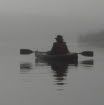Five Creatures: Uh-oh, I listed a bunch of officially rare creatures. That's far out of character. Here's Pet Peeve #6: being sent chasing hither and yon after reports of rare plants, wasting everybody's time and resources on an effort that might shift a development twenty or thirty metres left or right if something officially rare happens to be growing there that year (and visible during the week that I happen to be there). Let's face it: native prairie is rare. If oil is unlimited, or if technology is about to come up with a substitute, then there's no need to be drilling for the oil that's under native prairie. And if oil scarcity is looming, drilling on native prairie isn't going to do much to stave off the crunch.
So, other creatures I'd like to see instead of the official rarities? Brumbies! No, not really, I don't need to go flying halfway round the world just to see brumbies, and don't tell Garth I mentioned them, because he dearly longs to take the family to Australia. I figure I've got plenty to see right around here. I also have an irrational dread of meeting one of their deadly poisonous creatures. I can't imagine appreciating the wonder of the moment between being bitten or stung, and dropping dead.
How did brumbies come to mind? It must have been the article I saw recently about conflicts between grazing and parks management in the high country of Victoria. "The Man from Snowy River" would probably still make it onto a short list of my favourite movies, but I'd completely forgotten the word "brumbies." In Moose Mountain Provincial Park just north of here, we have a similar heritage of grazing within the park, and from what I have heard, the cattlemen have been quite proactive in figuring out ways to manage the grazing patterns and avoid overuse of particular areas. In the Australian article, they mentioned
...testing...virtual fencing technology that uses global positioning systems to plot exclusion areas. The information is stored in a collar or ear tag on cattle and a signal emitted when they approach a no-go zone."Signal" sounds like a euphemism for something that animal-rights activists might not like. What is it, a blue heeler's growl? Or would it be more like the tried-and-true signal that a cow gets from an electric fence? Say, I wonder if a growling fence would work. Speaking of electric fences, I fondly remember a young man from California who came up to Alberta to train me in collecting surface soil samples for microbial oil exploration. He gave me my first introduction to GPS technology, but Alberta gave him his first introduction to electric fences. Too bad I hadn't thought to warn him. He had a wonderful self-deprecating way of telling a story. He said he pulled his quad up to the fence, and went to lift the wire over it. He couldn't figure out why a wasp kept stinging him every time he grabbed the wire.
Back to the Australian grazing story: a GPS system to herd cattle is something I had already daydreamed about, several years ago. It was after I heard that grazing behaviour is substantially different without predators harassing the herds. Grass health declines under more constant, distributed grazing. I wondered if you could use a GPS collar system to keep herds bunched and moving, and thus keep pastures healthier and more productive. Sounds like my daydream just might come true.





No comments:
Post a Comment